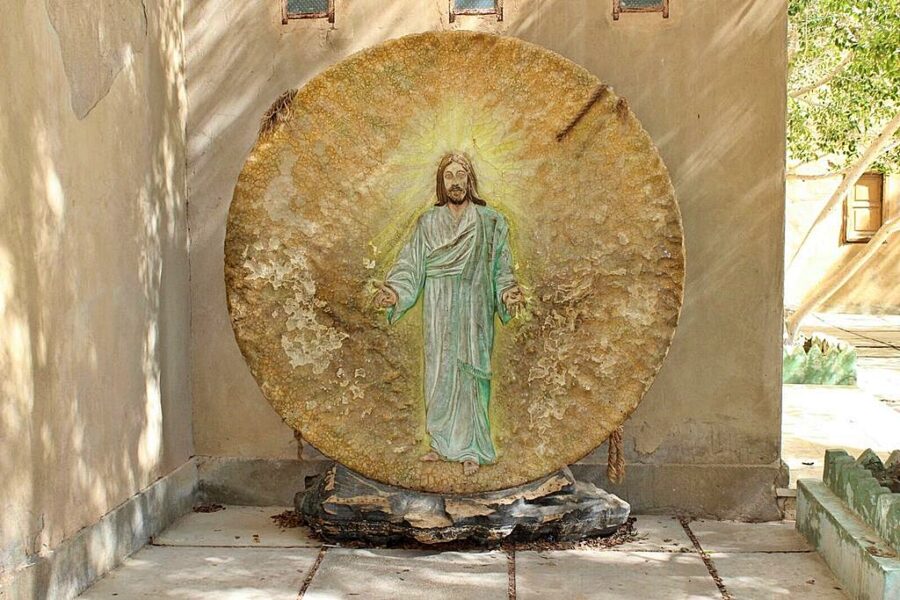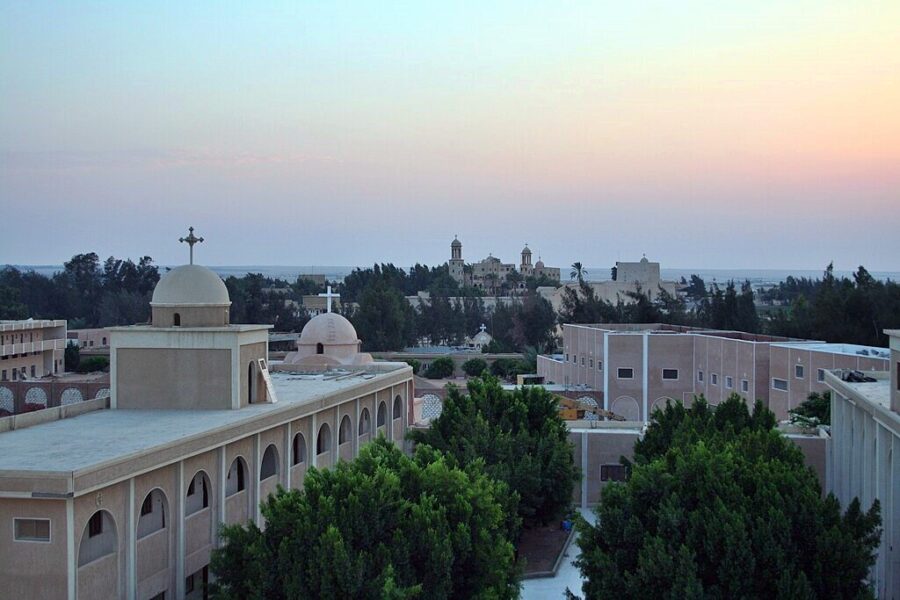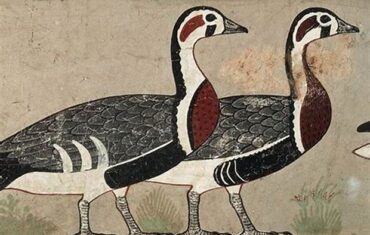Location of Wadi Al Natroun Monasteries
The area around Wadi Natrun is known as the liberation province (Mudiriyat al-Tahrir). In the 1950s, model villages were created here, olive groves, and vineyards were planted, in order to reclaim 25 thousand hectares from the desert. Now, after decades of careful reclamation, palm trees, flowers, and greenhouse plants grow along the road across the desert to Alexandria, spreading further as you move North.
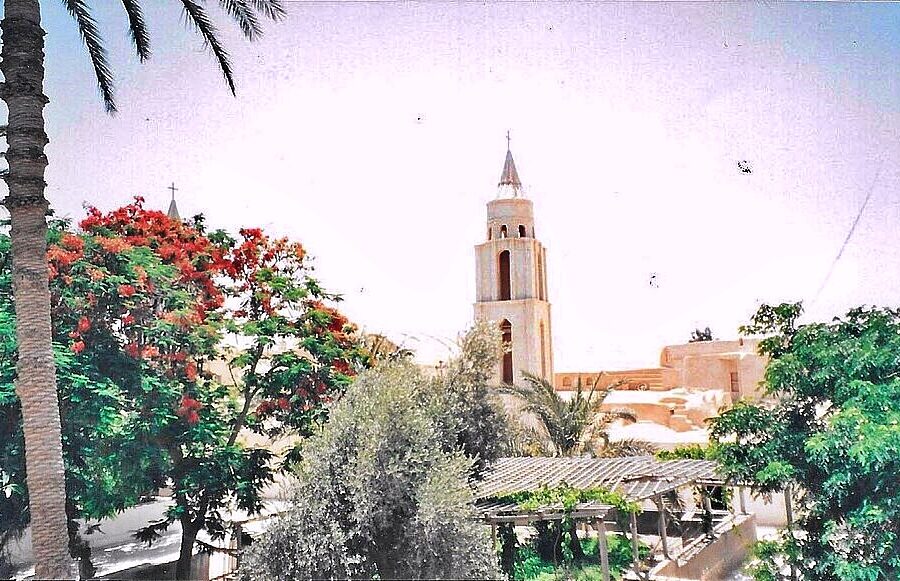 The valley of Wadi Natron is a depression in the middle of the road through the desert between Cairo and Alexandria. It acquired its name thanks to the deposits of sodium oxide, which was the main ingredient in the mummification process in ancient Pharaonic times. However, the most ancient heritage of the Wadi Natrun is its monasteries, which date back to the time when the movement of Christian monks was born, who were leaders in the spiritual sphere for all Coptic Egypt for the last 1500 years.
The valley of Wadi Natron is a depression in the middle of the road through the desert between Cairo and Alexandria. It acquired its name thanks to the deposits of sodium oxide, which was the main ingredient in the mummification process in ancient Pharaonic times. However, the most ancient heritage of the Wadi Natrun is its monasteries, which date back to the time when the movement of Christian monks was born, who were leaders in the spiritual sphere for all Coptic Egypt for the last 1500 years.
Their outer fortifications, necessary in the past centuries to protect them from the raids of the Bedouin, now hide those who today can be called the most prudent and purposeful monastics. The Coptic monastic movement experienced a rebirth in the 1980s, to cover twenty years after an English writer denied monasteries the right to exist because they were “of little interest except to specialists.”
How to get to Wadi Natron
The Wadi Natron valley can be a memorable day trip from Alexandria or Cairo. The easiest way to get there is to rent a car or take a taxi (450-600 pounds depending on the number of monasteries you want to visit). Traveling by public transport takes place in two stages. Buses from Cairo and the Western Nile Delta depart from the Turgoman terminal (departure every hour from 6.30 am to 6.30 PM; £ 75) and stop at bir hooker, where you will be able to hire a taxi for a tour of the monasteries for 250-300 pounds.
You can also take a Shuttle bus from Cairo (Aboud terminal) or Alexandria (enjoy this Gaber) to the Wadi Natron sanatorium on the 95th kilometer of the road through the desert-a group of hotels, gas stations, and cafes, where slow intercity buses also stop. From here, you can arrange a private taxi ride to the nearest monastery or hope to be picked up by one of the Coptic pilgrim buses that pass here.
If you return to Cairo or Alexandria by bus or regular taxi, you may have to pay the full price for the intercity transfer. Buses to Cairo depart every hour until 19.00 PM. But there are only a few of them going to Alexandria, and in the afternoon, when people are most likely to start returning from visiting the monasteries, there may only be two of them.
The Monasteries of Wadi Natron valley
Christian monasticism originated in the Eastern desert of Egypt, where the first Christian hermits sought to imitate Saint Anthony and formed primitive communities. However, it was in Wadi Natron that their rules and their influence were forged. In fact, it coincided in time with the persecution of Christians in the cities, especially during the time of Diocletian. Certainly, by the middle of the fourth century, several thousand monks and hermits were living here, accumulating a bitter hatred of paganism.
They settled accounts after Christianity became the state religion in 330, looting temples and libraries and killing scientists in Alexandria. E. M. Forster believed that they ” reject culture and are not capable of thinking. Their heroes were St. Ben, who left his wife on the eve of marriage, and St. Anthony, who believed that bathing was a sin, and as a result was transported across the Delta canals by an angel.” The Muslim conquest and the Bedouin raids led to the emergence of a besieged mentality among the monks, which led to laziness and dependence on the monastery’s servants.
Foreign travelers of the nineteenth century unanimously write it down them as lazy, dirty, intolerant, and ignorant – the exact opposite of the monks who now live here. Each of the four monasteries of Wadi Natron was completely destroyed and rebuilt at least once between the time of its Foundation and the end of the fourth century. Most of what you can see now dates from the eighth century or later.
Essential Components of any Coptic Monastery:
Each monastery includes:
- An outer surrounding high Wall
- One or more churches,
- The central citadel that is accessed via a drawbridge
- A house of bakery
- Storehouses
- Wells allowed the monks to withstand a siege.
- Many built-in chapels; Their low doorways make incoming visitors bow humbly.
Their churches, like all Coptic temples, are divided into sections. Haikal (the main part of the temple) consists of an altar, which is hidden behind an iconostasis inlaid with a screen, through which you can look with the connivance of a guide. Oppositely is the choir, designed for Coptic Christians, and the board of directors, consisting of two parts. The catechumens (those preparing for conversion) stand closest to the choir, while the sinners (known as “mourners”) are usually sent back.
Practical recommendations for visiting the monasteries of Wadi Natron
The time for visiting is different in each monastery, as well as the period for which they are closed during the five seasonal fasts: the 43 days before Christmas, three days in commemoration of Jonah’s stay in the kit, 55 days preceding Lent, the fast of the Holy Apostles (from Whitsunday to July 12), and fifteen days marking the assumption of the virgin Mary (August 7-22). The only monastery that opens every day of the year is Deir Anba Bishoy.
Deir al-Suryani and Deir El-Baramos, although they are closed during all holidays, have certain opening hours. Only those who have written permission from the Coptic Patriarch in Cairo (behind St. Mark’s Cathedral, 222 Sharia Ramses, Abbasiya) or in Alexandria (at St. Mark’s Cathedral on Sharia al-Kineesa al-Kobtiyya) will be allowed to enter Deir Abu Makar. The Patriarchate can confirm the opening dates of the individual monasteries. It is better to avoid visiting on Fridays, Saturdays, or public holidays when the monasteries are filled with crowds of Coptic pilgrims from all over Egypt.
Male tourists who wish to spend the night in the monastery must obtain written permission from the appropriate “residence” in Cairo: Deir Anba Bishoy; Deir al-Suryani; Deir El-Baramos. Since the other tenants are ardent pilgrims, you should at least try to attend prayers and leave donations for the provided tea and bread. Women are not allowed to sleep within the confines of any of the monasteries. You can stay in several motels located along a deserted road near the turnoff to Wadi Natrun.
The Monastery of Anba Bishoy  The most accessible of the monasteries is Deir Anba Bishoy (daily: winter 7: 00-18:00; summer 7:00-20: 00), 10 kilometers from the highway with a lettered sign on the stone pavement. More than fifty monks and novices live here. The monastery of Saint Bishoy into streams of Coptic pilgrims. English-speaking father usually shows to foreigners in the neighborhood.
The most accessible of the monasteries is Deir Anba Bishoy (daily: winter 7: 00-18:00; summer 7:00-20: 00), 10 kilometers from the highway with a lettered sign on the stone pavement. More than fifty monks and novices live here. The monastery of Saint Bishoy into streams of Coptic pilgrims. English-speaking father usually shows to foreigners in the neighborhood.
The legend of Saint Bishoy:
It says that he may have been one of the first monks in the Wadi Natrun. An angel announced to the Saint’s mother that he had been chosen to serve God, even before he was born in 320. Two decades later, he came in here to learn from the Free BEMO with John “Short”.
Following a fairly free chronology, the legend also claims that later Bishoy met Christ in the form of an old man, carried him to the Lutheran Church, washed his feet, and as a reward he was allowed to drink the remaining water. However, it is reported that since the death of Saint Bishoy in 417, his body has remained incorruptible in its Mathew coffin. Every year, on July 17, a procession takes it around the Church. Next to him lies a Paul from Tamaha, which is revered for the fact that he committed suicide seven times.
The Church of St. Bishoy:
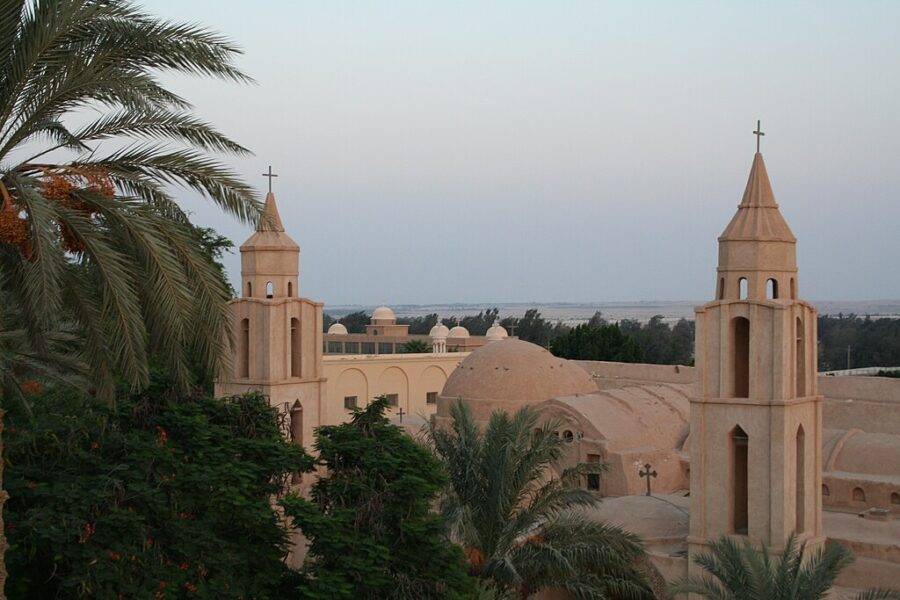 It is the oldest of the five churches of the monastery, its peculiarity is the existence of three chaikals Dating from the fourth, ninth and tenth centuries. The citadel, built four hundred years later, contains chapels on the first floor (at the rear) and on the second floor above the drawbridge. There is also a fifth-century well where Berber nomads washed their swords after the murder of the 49 martyrs of the monastery of Saint Macarius.
It is the oldest of the five churches of the monastery, its peculiarity is the existence of three chaikals Dating from the fourth, ninth and tenth centuries. The citadel, built four hundred years later, contains chapels on the first floor (at the rear) and on the second floor above the drawbridge. There is also a fifth-century well where Berber nomads washed their swords after the murder of the 49 martyrs of the monastery of Saint Macarius.
The building with many domes, located farthest from Guyana – was the residence of Pope Shenouda III – the Of the Coptic Pope. He used it as a temporary shelter. It is here that he was exiled for several years by Sadat and sometimes ostentatiously locks himself up here, protesting against the mistreatment of Copts. Most of the Coptic popes were chosen from the monks of Wadi Natrun, and in particular from Deir Anba Bishoy
The Deir (monastery) of al-Suryan
A sixth-century controversy over the theological significance of the blessed virgin led to a breakaway monk founding another monastery 500 meters from Saint Bishoy. After they’re-joined the official Church, it was purchased by a group of Syrian regime has deliberately monks, from which it derives its name Deir al-Suryani (in winter, Monday-Friday and Sunday 9: 00-18:00, Saturday 9:00-15:00; in summer, Monday-Friday and Sunday 9:00-19:00, Saturday 9:00-17: 00). It was here that Robert Curzon arrived in search of ancient manuscripts (which served as an ostensible excuse for his trip to the Balkan and Levantine monasteries in the 1830s) and found them lying on the floor or serving as a cover for phials, all of them “smeared with mud.” In the oil cellar of the citadel there was “a vast amount of unused parchment,” while in the library of the Consistory of the Abyssinian monks, Aramaic texts were hung from pegs in the individual leather bags. Now the ancient volumes are lovingly stored in a modern library, and recently a cache of manuscripts from 1500 years ago was opened. The monastery also boasts the remains of approximately twelve saints and a lock of Mary Magdalene’s hair.
The main Church of Deir al-Suryani is the Church of the blessed virgin (al-Adhra),
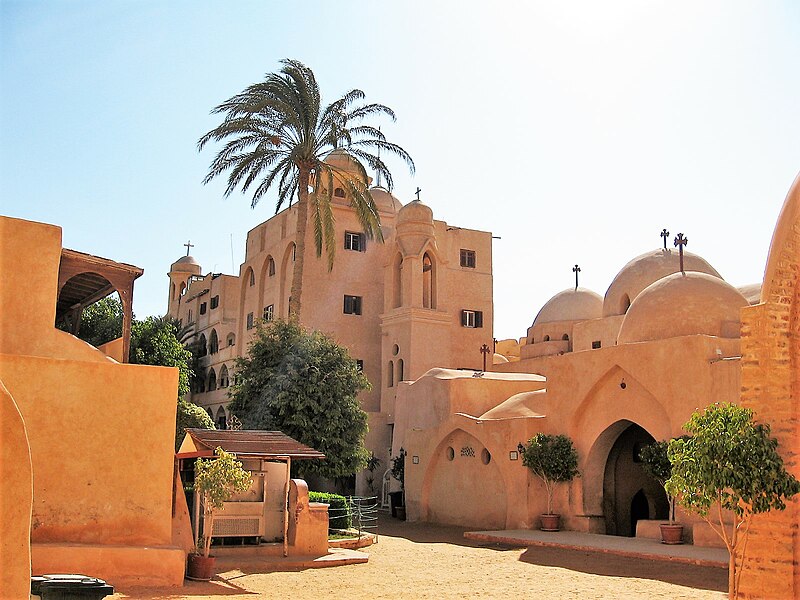
It was built around 980. It's Haikal (Shrine) is decorated with plaster ornaments and magnificent “Doors of prophecies” made of ebony, inlaid with ivory panels, which depict the apostles and the seven epochs of the Christian era, culminating in the break with the Orthodox Church and the arrival of Islam. Some wall paintings Dating back to the time of the Church’s Foundation were recently discovered under the plaster, and they can be seen through small holes.
A dark passage at the back of the Church leads to a cave where Bishoy tied his hair to a chain hanging from the ceiling so that he would not fall asleep for four days until the vision of Christ appeared. The marble basin (Lacan) in the nave serves the Abbot when he, imitating the act of Christ in Holy week, washes the feet of the monks on Maundy, Thursday. It is said that the huge tamarind tree in the Park grew out of the staff of Saint Ephraim. As a monk, he stuck it in the ground after one of his companions accused him of worldly partiality for it. After becoming Coptic Pope, he established a cordial relationship with the Fatimid Caliph in 997.
The monastery (Deir) El Baramos
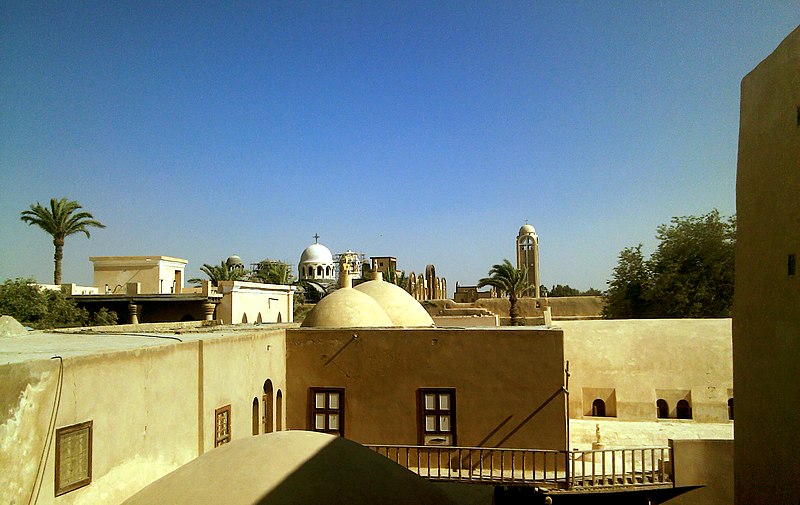
One of the more remote monasteries of Deir El-Baramos (daily: winter 9: 00-17:00; summer 9:00-17: 00) can be reached by walking 4 kilometers to the North on the road that begins in the vicinity of Deir Anba Bishoy. The monastery, located in the midst of barren Sands, but it is still away from the Madding crowds. Outside, visitors are greeted by a painting depicting the black Saint Moses, a Nubian thief who became a monk under the influence of Saint Isidore.
The monastery itself was founded by Saint Macarius in 340, making it the oldest of the four surviving monasteries in the Wadi Natrun. It is named the “Monastery of the Romans” in honor of Maximus and Domadius, two sons of the Roman Emperor Valencia. They died of immoderate fasting; the youngest of them was only nineteen years old. It is generally believed that their bodies are buried behind the Church of the blessed virgin, whose main altar is used only once a day since the womb of Mary gave birth to only one child.
The next altar, usually hidden behind a curtain, is reserved for the” Immaterial fathers, ” for the souls of departed saints and abbots, who sometimes sprinkled it with drops of water. The relics of Moses and Isidore are enclosed in glass vessels; pilgrims throw their petitions into their funeral Biers. Note the T-shirt marked with a blood cross – a relic leftover from an exorcism ceremony held at the monastery in the 1980s. The flying Efreet (spirit) left this brown mark when it was exorcised from the body of its possessed victim.
Restoration work has uncovered layers of medieval frescoes in the nave, at the Western end of which is a column with Syriac inscriptions. It was behind this column that Saint Arsenious prayed, filling his mouth with pebbles, pronouncing each word sparingly. The ninth-century Church (whose bell towers of varying heights symbolize the age of the Biggest and Domidus respectively) shares a courtyard with a vineyard with the citadel and four other churches. There are eight monks and novices in the Deir Al-Beramus, one of whom will show you around.
Sellia and birdlife
The monks can also tell you about Selliya (or El-mun), the name given to the ruins of about five hundred hermit huts scattered over an area of 30 kilometers North of Deir Al-Beramus. Sellia was founded by Saint Anthony, who, according to legend, told the monks of Wadi Natrun who wanted to become hermits: “Let us eat at the ninth hour, and then go forward and cross the desert and choose a place.”
Sellia kept in touch with the pilgrim city of Abu Min until the stream that provided freshwater dried up. In 1995, the American archaeologists excavated the monastery of St. John. They also found traces of five underground monasteries that were “lost” after being discovered by Prince Tusun in 1930 The marble base of the (Lacan) in the ship you keep the Abbot when he, imitating the act of Christ in Holy week, washes the feet of the monks on Maundy, Thursday. It is said that the huge tamarind tree in the Park grew out of the staff of Saint Ephraim. As a monk, he stuck it in the ground after one of his companions accused him of worldly partiality for it. After becoming Coptic Pope, he established a cordial relationship with the Fatimid Caliph in 997.
These remote parts of the Wadi Natrun have a melancholy beauty. Numerous salt lakes are enclosed in a frame of the deposits of sodium oxide, a mixture of sodium carbonate and sodium bicarbonate, which were used by the ancient Egyptians to dehydrate the bodies of the dead and produce glass. Ducks, water hens, snipes, and sandpipers are typical examples of the avian fauna that live around these lakes, which also serve as a refuge for the last specimens of the Egyptian wild paper.
It is just a dwarf plant species that once grew along the entire Nile Valley but gradually disappeared. Here it appeared in this form because of the salinity of the water. The last huge paper (which reached 6 meters) was discovered by a Prussian soldier in the Delta in the middle of the nineteenth century. Today it grows only on plantations, thanks to the fact that Dr. Ragab, who discovered the lost technique of making paper, began to produce Souvenirs based on it.
The monastery of Anba Makar (St. Makarios)
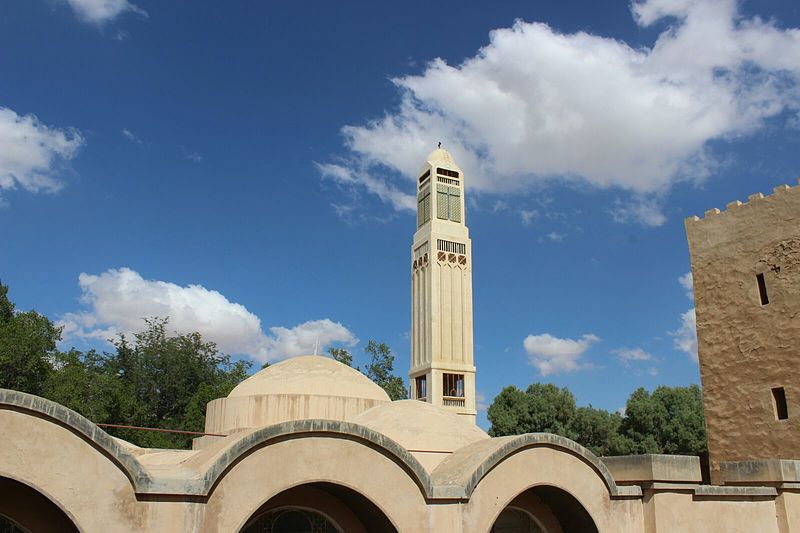
The oldest and most remote of the monasteries, Deir Abu Makar, is located 18 kilometers Southeast of Saint Bishoy. It can also be reached by taking a nine-kilometer branch from the desert road that begins halfway between the main turnoff and the city of Sadat. It is not intended for casual visitors but will allow those who have written permission from the Patriarchate.
To get inside the monastery, surrounded by a ten-meter wall, visitors will have to pull the bell-rope. In bygone times, two huge millstones were prepared to block the door from the Bedouin nomads. The founder of the monastery, Saint Makarios, died in 390 “after sixty years of privation in the various places of seclusion,” the last twelve of which he spent in the hermitages of the Wadi Natrun.
It is said that he repented so much for killing the mosquito that he retired to the swamps for six months, where he was bitten so severely that “his body became so unrecognizable that his brothers could only recognize him by the sound of his voice.” The only indulgence for this strict fastener was a leaf of raw cabbage for Breakfast on Sunday.
Despite constant looting, Abu Makar preserves the bodies of several Coptic popes buried here and 49 other martyrs killed by the Berbers in 444. In 1978, the monks discovered what they believed to be the head of John the Baptist, although Venice, Aleppo, and Damascus have long claimed the same. Since its greatest decline in 1969, when only six monks lived here, the monastery has acquired a hundred brothers, a modern printing press, and a farm with six hundred workers.
The fact that the Abbot has set the following goal: a monk should contain a thousand of the laity. In an attempt to do this, the monks mastered the point irrigation system and cow embryo transplantation technology, giving life to a landscape that “boasted nothing but salt and sodium oxide, to which it owed its sterility and its name” (Murray’s Handbook, 1891)
